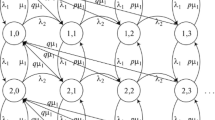Abstract
The open exponential queuing network with negative customers (G-network) was considered.For each arriving customer, given was a set of its random parameters such as the route defining the sequence of network nodes passed by the customer, route length, size, and servicing duration at each stage of the route. It was assumed that the negative customer arriving to the sth node with the probabilities ω s and ω s + either kills the positive customer in a randomly chosen server or does not affect it at all and with the probability ω s – =1 – ω s – ω s + transforms it into a negative customer which after an exponentially distributed time arrives to the s′th node with the given probability. The multidimensional stationary probability distribution of the network states was proved to be representable in the multiplicative form.
Similar content being viewed by others
REFERENCES
Kleinrock, L., Queuing Systems, New York: Wiley, 1976. Translated under the title Teoriya massovogo obsluzhivaniya, Moscow: Mashinostroenie, 1979.
Basharin, G.P. and Tolmachev, A.L., Theory of Queuing Networks and Its Applications to the Dataprocessing Systems, Itogi Nauki Tech., 1983, vol. 21, pp. 3–119.
Zhozhikashvili, V.A. and Vishnevskii, V.M., Seti massovogo obsluzhivaniya. Teoriya i primenenie k setyam EVM(Queuing Networks. Theory and Application to the Computer Networks), Moscow: Radio i Svyaz', 1988.
Basharin, G.P., Bocharov, P.P., and Kogan, Ya.A., Analiz ocheredei v vychislitel'nykh setyakh. Teoriya i metody rascheta(Analysis of Queues in Computer Networks. Theory and Methods of Calculation), Moscow: Nauka, 1989.
Shwarz, M., Seti svyazi: protokoly, modelirovanie i analiz(Communication Networks: Protocols, Modeling, and Analysis), Moscow: Nauka, 1992.
Gelenbe, E. and Pujolle, G., Introduction to Queuing Networks, New York: Wiley, 1998.
Vishnevskii, V.M., Teoreticheskie osnovy proektirovaniya komp'yuternykh setei(Theoretical Fundamentals of Computer Network Design), Moscow: RITS “Tekhnosfera,” 2003.
Kelly, F.P., Reversibility and Stochastic Networks, New York: Wiley, 1979.
Walrand, J., An Introduction to Queueing Networks, Englewood Cliffs: Prentice Hall, 1988. Translated under the title Vvedenie v teoriyu setei massovogo obsluzhivaniya, Moscow: Mir, 1993.
Van Dijk, N.M., Queuing Networks and Product Forms, New York: Wiley, 1993.
Jackson, J.R., Jobshop Like Queuing Systems, Manag. Sci., 1963, vol. 10, pp. 131–142.
Baskett, F., Chandy, K.M., Muntz, R.R., et al., Open, Closed, and Mixed Networks of Queues with Different Classes of Customers, J. ACM, 1975, vol. 22, pp. 248–260.
Artalejo, J.R., G-networks: A Versatile Approach forWork Removal in Queuing Networks, Eur. J. Oper. Res., 2000, vol. 126, pp. 233–249.
Bocharov, P.P. and Vishnevskii, V.M., G-networks: Development of the Theory of Multiplicative Networks, Avtom. Telemekh., 2003, no. 5, pp. 46–74.
Gelenbe, E., Queuing Networks with Negative and Positive Customers, J. Appl. Prob., 1991, vol. 28, pp. 656–653.
Gelenbe, E., Glynn, P., and Sigman, K., Queues with Negative Arrivals, J. Appl. Prob., 1991, vol. 28, pp. 245–250.
Gelenbe, E. and Schassberger, R., Stability of G-networks, Prob. Eng. Inf. Sci., 1992, vol. 6, pp. 271–276.
Gelenbe, E., G-networks with Instantaneous Customer Movement, J. Appl. Prob., 1993, vol. 30, no. 3, pp. 742–748.
Gelenbe, E., G-networks with Signals and Batch Removal, Prob. Eng. Inf. Sci., 1993, vol. 7, pp. 335–342.
Gelenbe, E., G-networks: A Unifying Model for Neural and Queuing Networks, Ann. Oper. Res., 1994, vol. 48, pp. 433–461.
Fourneau, J.N., Gelenbe, E., and Suros, R., G-networks with Multiple Classes of Negative and Positive Customers, Theor. Comput. Sci., 1996, vol. 155, pp. 141–156.
Gelenbe, E. and Labed, A., G-networks with Multiple Class of Signals and Positive Customers, Eur. J. Oper. Res., 1998, vol. 108, pp. 293–305.
Gelenbe, E. and Shachnai, H., On G-networks and Resource Allocation in Multimedia Systems, Eur. J. Oper. Res., 2000, vol. 126, pp. 308–318.
Gelenbe, E. and Fourneau, J.N., G-networks with Resets, Performance Evaluation, 2002, vol. 49, pp. 179–192.
Bocharov, P.P., Gavrilov, E.I., D'Apice, C., and Pechinkin, A.V., Product Form Solution for Gnetworks with Dependent Service, Proc. Int. Conf. on Heterogeneous Networks, HETNET'03, Ilkley, 2003, pp. 28-1–28-11.
Bocharov, P.P., Gavrilov, E.I., D'Apice, C., and Pechinkin, A.V., On Decomposition of Queuing Networks with Dependent Servicing and Negative Customers, Avtom. Telemekh., 2004, no. 1, pp. 97–116.
Pechinkin, A.V. and Rykov, V.V., On Decomposition of the Queuing Networks with Dependent Servicing
Bocharov, P.P., Gavrilov, E.I., and Pechinkin, A.V., Analysis of the G-network with Changing Customer
Rights and permissions
About this article
Cite this article
Bocharov, P.P., Gavrilov, E.V. & Pechinkin, A.V. Exponential Queuing Network with Dependent Servicing, Negative Customers, and Modification of the Customer Type. Automation and Remote Control 65, 1066–1088 (2004). https://doi.org/10.1023/B:AURC.0000038714.32438.d0
Issue Date:
DOI: https://doi.org/10.1023/B:AURC.0000038714.32438.d0




